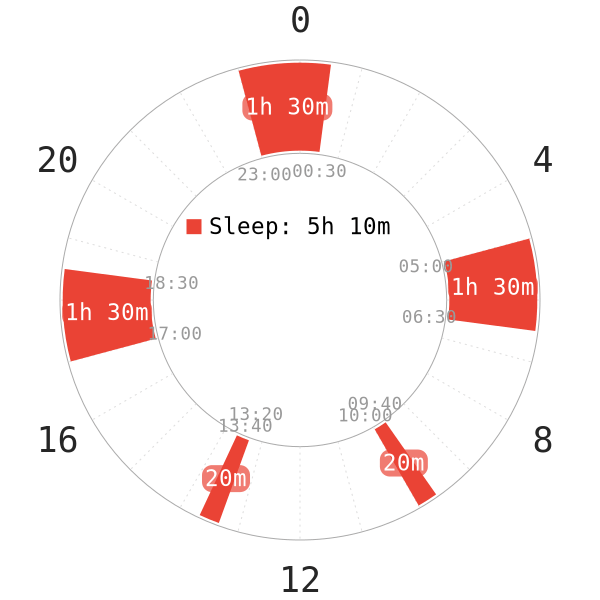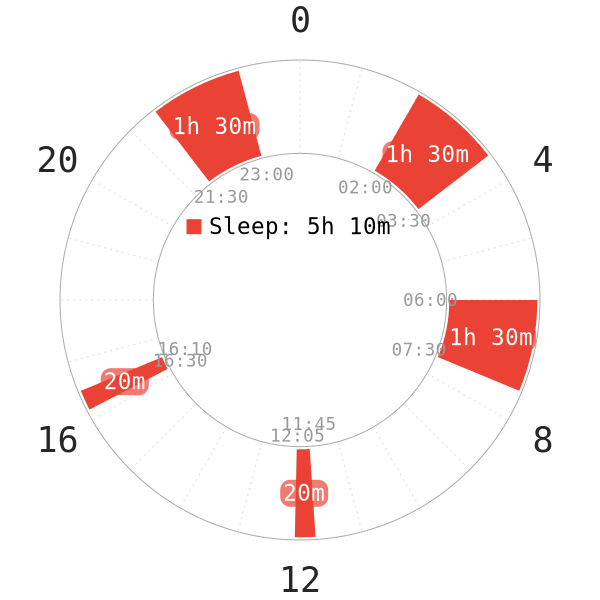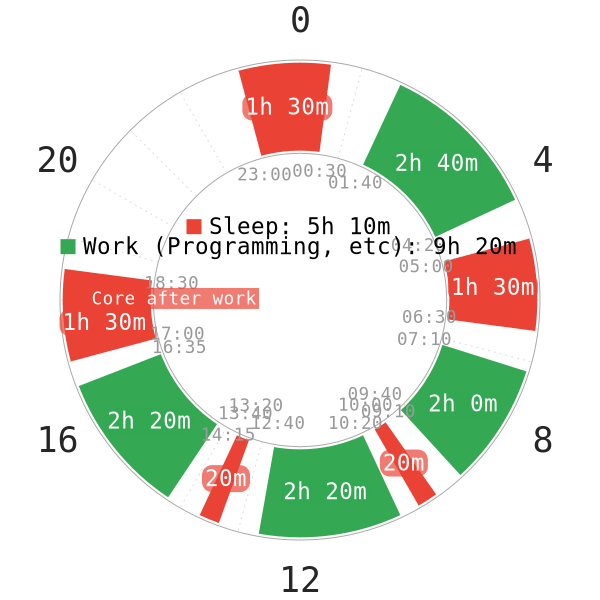
Tri Core 2, or TC2 for short, is the second polyphasic schedule in the Tri Core family. It is still a multi-core schedule with 3 core sleeps, but now has 2 naps total each day. This bumps the total sleep to 5h10m, which is equivalent to the likes of E2. LichterLoh, a Discord member, was the creator of the schedule.
Content
Mechanism
Tri Core 2 is also one of the newer Tri Core prototypes. Its intent and design are largely different from those of the predecessors Triphasic and TC1.
The idea behind TC2 is not to cram all core sleeps into the night like TC1 or having somewhat equidistant cores like on Triphasic. The following differences about TC2 are as follows.
Cores
- The sleep frequency of TC2 is the highest among the Tri Core family. It constitutes 5 sleep blocks per day, which is as high as DC3 and E4.
- All sleep blocks spread across the day, with small wake periods in between.
- Two core sleeps are at night hours. This is similar to Dual Core sleep, where the midnight core favors SWS; the core around sunrise hours favors REM sleep.
- The third core around late afternoon hours coincides with the timing after school and work hours. This serves as a way to give a long recovery after a long day. It is likely a mixed core with both REM and SWS.
- The wake gap between 2 night cores is considerably larger than on TC1. This allows for more activities and more wake time at night.
Because of a generally bigger wake gap between the cores, it may be easier to fall asleep in the 2 cores around graveyard hours (~midnight to 8 AM). This can lower the chance of oversleeping with subsequent naps and another core in late afternoon. This late afternoon core likely behaves the same as the daytime core on Triphasic, giving mixed SWS and REM.
Naps
- The daytime naps serve to provide a high frequency of sleep and reinforce alertness levels. Because of the high frequency of sleeps, staying awake between each sleep on TC2 may not be as difficult as on Triphasic and TC1.
- TC2 also has the most sleep in the Tri Core family. This is because the core duration is already at its minimum (1 full cycle) while there are 2 extra naps.
- One of the naps may contain REM sleep, while the other only has light sleep.
Adaptation
Tri Core 2 has a decent total sleep, which may factor in an easier adaptation than its predecessors. However, like other split-core schedules, TC2 looks overwhelming for any non-natural segmented sleepers.
- Cold turkey adaptations can therefore be very difficult for non-natural segmented sleepers.
- It would be more optimal to gradually transition from a Segmented or DC1 schedule to get used to segmenting cores. Even though TC2 is the second and last schedule in the Tri Core family, adapting to TC1 first is unnecessary and would mismatch the rhythm.
The sleep blocks being in close proximity can amplify the sleep onset issues at the beginning of adaptation. Falling asleep midway into each core can also likely yield SWS and REM wakes; this is largely owing to the mechanic of a regular 90m sleep block. However, the support from the extra naps provide more opportunity to learn the short naps and fall asleep effectively.
During adaptation, the cores at night will likely be the most burdensome to handle. The daytime sleep blocks, on the contrary, are easier to handle. The third core also looks like a daytime siesta. Because of the limited adaptation samples, it is unclear if TC2 is harder than TC1.
Alternate Variants

Aside from this standard variant, no other variants of TC2 have proved to work thus far. However, having a similar setup to TC1 may be viable to attempt.
- The placement of 2 naps would resemble the nap positions on DC2, E3, to name a few.
- One nap is around lunch break, while the other one is after work.
- This setup also limits daytime sleep with just 2 naps.
Despite looking viable on paper, this TC2 variant requires more adaptation attempts for more extensive testing.
Lifestyle Considerations
So far, there are very few adaptations to TC2. This is the case because:
- It has massively inconvenient scheduling. Multiple sleep blocks intrude normal social hours that require wake time.
- The total sleep is high for a schedule with 5 sleep blocks per day.
- The amount of daytime sleep (including the third core) is more than most, if not all polyphasic schedules. In the long run, there would be low chance to sustain the schedule due to its aforementioned constraints.
- Scheduling meals around the sleep blocks can be annoying for a lot of people. The wake periods between each sleep is small.
However, Tri Core 2 may have certain perks for usage:

- It benefits very flexible jobs (e.g, work at home, self-employed) and work-at-your-pace lifestyle.
- In very rare situations, TC2 may also fit people with free time after work (to have a core).
- Tri Core 2 may potentially be more flexible than Triphasic and TC1, thanks to the extra naps.
Despite all the possible perks, TC2 is still vastly shadowed by other more comfortable schedules. This includes E2 (same total sleep), E3-extended (easier adaptation), DC1, DC2, and its own Tri Core counterparts. It is overall not a long-term polyphasic schedule, despite some viability.
Extending any of the core sleeps by 90m proves to be more of a nuisance to schedule 5 sleeps; thus, it is highly ill-advised to attempt any extended versions. Because TC2 looks very redundant, it is a better approach to attempt any of the more convenient schedules.
Main author: GeneralNguyen
Page last updated: 3 April 2021
